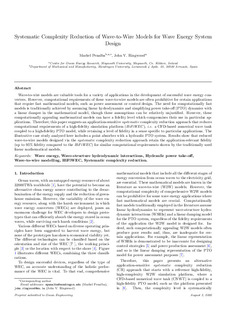| dc.contributor.author | Penalba, Markel | |
| dc.contributor.other | Ringwood, John V. | |
| dc.date.accessioned | 2020-09-25T12:40:45Z | |
| dc.date.available | 2020-09-25T12:40:45Z | |
| dc.date.issued | 2020 | |
| dc.identifier.issn | 0029-8018 | en |
| dc.identifier.other | https://katalogoa.mondragon.edu/janium-bin/janium_login_opac.pl?find&ficha_no=159941 | en |
| dc.identifier.uri | https://hdl.handle.net/20.500.11984/1837 | |
| dc.description.abstract | Wave-to-wire models are valuable tools for a variety of applications in the development of successful wave energy converters. However, computational requirements of these wave-to-wire models are often prohibitive for certain applications that require fast mathematical models, such as power assessment or control design. The need for computationally fast models is traditionally achieved by assuming linear hydrodynamics and simplifying power take-off (PTO) dynamics with a linear damper in the mathematical model, though these assumptions can be relatively unjustified. However, these computationally appealing mathematical models can have a fidelity level which compromises their use in particular applications. Therefore, this paper suggests an application- sensitive systematic complexity reduction approach that reduces computational requirements of a high-fidelity simulation platform (HiFiWEC), i.e. a CFD-based numerical wave tank coupled to a high-fidelity PTO model, while retaining a level of fidelity in a sense specific to particular applications. The illustrative case study analysed here includes a point absorber with a hydraulic PTO system. Results show that reduced wave-to-wire models designed via the systematic complexity reduction approach retain the application-relevant fidelity (up to 95% fidelity compared to the HiFiWEC) for similar computational requirements shown by the traditionally used linear mathematical models. | en |
| dc.description.sponsorship | Science Foundation Ireland | es |
| dc.language.iso | eng | en |
| dc.publisher | Elsevier Ltd. | en |
| dc.rights | © 2020 Elsevier Ltd. | en |
| dc.subject | Wave energy | en |
| dc.subject | Wave-structure hydrodynamic interactions | en |
| dc.subject | Hydraulic power take-off | en |
| dc.subject | Wave-to-wire modelling | en |
| dc.subject | HiFiWEC | en |
| dc.subject | Systematic complexity reduction | en |
| dc.title | Systematic complexity reduction of wave-to-wire models for wave energy system design | en |
| dcterms.accessRights | http://purl.org/coar/access_right/c_f1cf | en |
| dcterms.source | Ocean Engineering | en |
| local.contributor.group | Mecánica de fluidos | es |
| local.description.peerreviewed | true | en |
| local.identifier.doi | https://doi.org/10.1016/j.oceaneng.2020.107651 | en |
| local.embargo.enddate | 2022-12-31 | |
| local.contributor.otherinstitution | https://ror.org/048nfjm95 | es |
| local.source.details | Vol. 217. N. Art. 107651, 2020 | en |
| oaire.format.mimetype | application/pdf | |
| oaire.file | $DSPACE\assetstore | |
| oaire.resourceType | http://purl.org/coar/resource_type/c_6501 | en |
| oaire.version | http://purl.org/coar/version/c_ab4af688f83e57aa | en |







